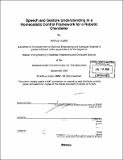Speech and gesture understanding in a homeostatic control framework for a robotic chandelier
Author(s)
Juster, Joshua
DownloadFull printable version (7.000Mb)
Other Contributors
Massachusetts Institute of Technology. Dept. of Electrical Engineering and Computer Science.
Advisor
Deb Roy.
Terms of use
Metadata
Show full item recordAbstract
We describe a home lighting robot that uses directional spotlights to create complex lighting scenes. The robot senses its visual environment using a panoramic camera and attempts to maintain its target goal state by adjusting the positions and intensities of its lights. Users can communicate desired changes in the lighting environment through speech and gesture (e.g., "Make it brighter over there"). Information obtained from these two modalities are combined to form a goal, a desired change in the lighting of the scene. This goal is then incorporated into the system's target goal state. When the target goal state and the world are out of alignment, the system formulates a sensorimotor plan that acts on the world to return the system to homeostasis.
Description
Thesis (M. Eng.)--Massachusetts Institute of Technology, Dept. of Electrical Engineering and Computer Science, 2004. Includes bibliographical references (leaf 40).
Date issued
2004Department
Massachusetts Institute of Technology. Department of Electrical Engineering and Computer SciencePublisher
Massachusetts Institute of Technology
Keywords
Electrical Engineering and Computer Science.